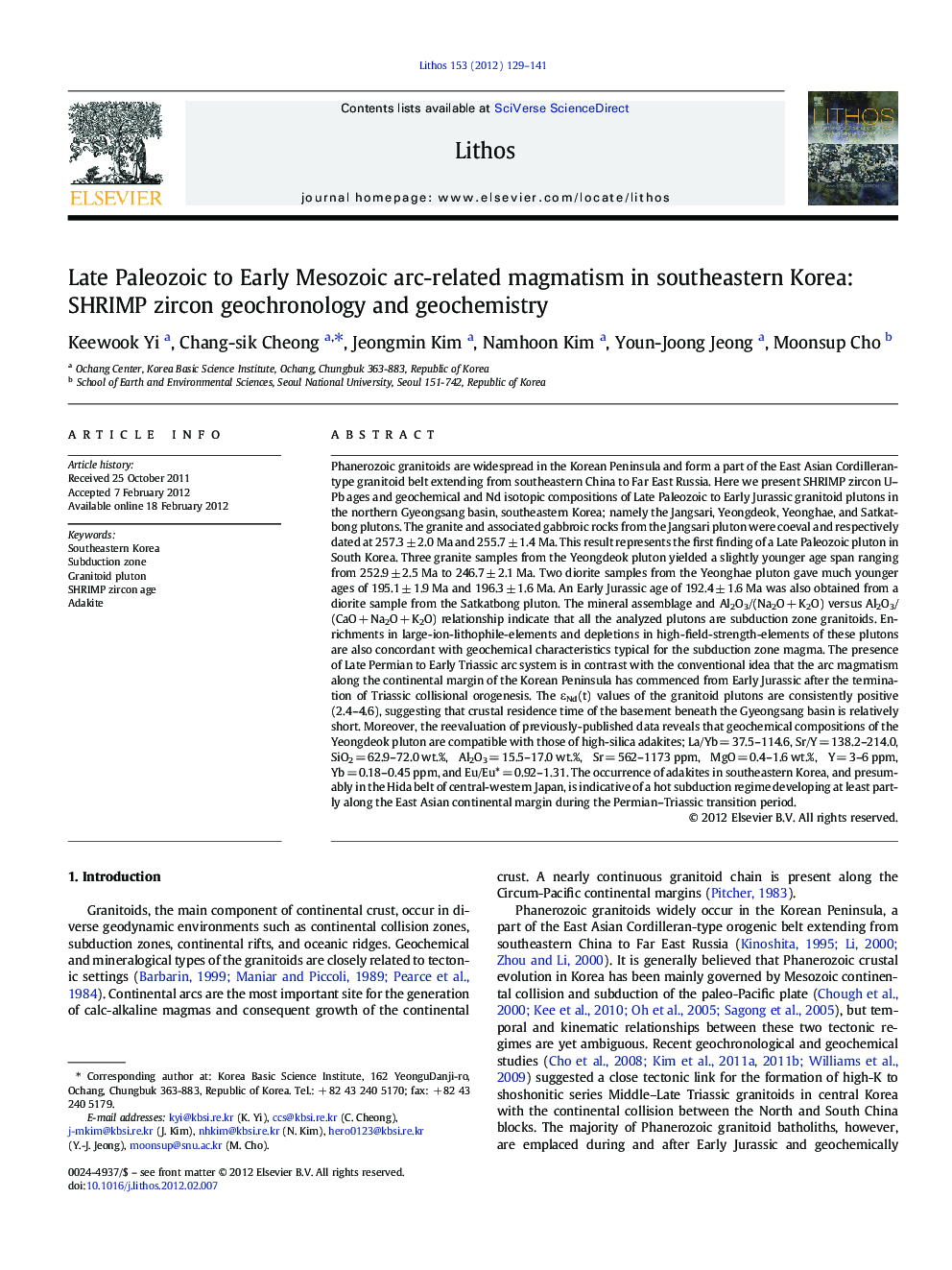| کد مقاله | کد نشریه | سال انتشار | مقاله انگلیسی | نسخه تمام متن |
|---|---|---|---|---|
| 4716433 | 1638700 | 2012 | 13 صفحه PDF | دانلود رایگان |

Phanerozoic granitoids are widespread in the Korean Peninsula and form a part of the East Asian Cordilleran-type granitoid belt extending from southeastern China to Far East Russia. Here we present SHRIMP zircon U–Pb ages and geochemical and Nd isotopic compositions of Late Paleozoic to Early Jurassic granitoid plutons in the northern Gyeongsang basin, southeastern Korea; namely the Jangsari, Yeongdeok, Yeonghae, and Satkatbong plutons. The granite and associated gabbroic rocks from the Jangsari pluton were coeval and respectively dated at 257.3 ± 2.0 Ma and 255.7 ± 1.4 Ma. This result represents the first finding of a Late Paleozoic pluton in South Korea. Three granite samples from the Yeongdeok pluton yielded a slightly younger age span ranging from 252.9 ± 2.5 Ma to 246.7 ± 2.1 Ma. Two diorite samples from the Yeonghae pluton gave much younger ages of 195.1 ± 1.9 Ma and 196.3 ± 1.6 Ma. An Early Jurassic age of 192.4 ± 1.6 Ma was also obtained from a diorite sample from the Satkatbong pluton. The mineral assemblage and Al2O3/(Na2O + K2O) versus Al2O3/(CaO + Na2O + K2O) relationship indicate that all the analyzed plutons are subduction zone granitoids. Enrichments in large-ion-lithophile-elements and depletions in high-field-strength-elements of these plutons are also concordant with geochemical characteristics typical for the subduction zone magma. The presence of Late Permian to Early Triassic arc system is in contrast with the conventional idea that the arc magmatism along the continental margin of the Korean Peninsula has commenced from Early Jurassic after the termination of Triassic collisional orogenesis. The εNd(t) values of the granitoid plutons are consistently positive (2.4–4.6), suggesting that crustal residence time of the basement beneath the Gyeongsang basin is relatively short. Moreover, the reevaluation of previously-published data reveals that geochemical compositions of the Yeongdeok pluton are compatible with those of high-silica adakites; La/Yb = 37.5–114.6, Sr/Y = 138.2–214.0, SiO2 = 62.9–72.0 wt.%, Al2O3 = 15.5–17.0 wt.%, Sr = 562–1173 ppm, MgO = 0.4–1.6 wt.%, Y = 3–6 ppm, Yb = 0.18–0.45 ppm, and Eu/Eu* = 0.92–1.31. The occurrence of adakites in southeastern Korea, and presumably in the Hida belt of central-western Japan, is indicative of a hot subduction regime developing at least partly along the East Asian continental margin during the Permian–Triassic transition period.
Figure optionsDownload as PowerPoint slideHighlights
► SHRIMP zircon dating yielded Late Permian to Early Jurassic ages of granitoid plutons in SE Korea.
► Geochemistry of the plutons reflects an arc-related tectonic setting.
► Adakitic signatures of a pluton indicate a hot subduction environment.
Journal: Lithos - Volume 153, 15 November 2012, Pages 129–141